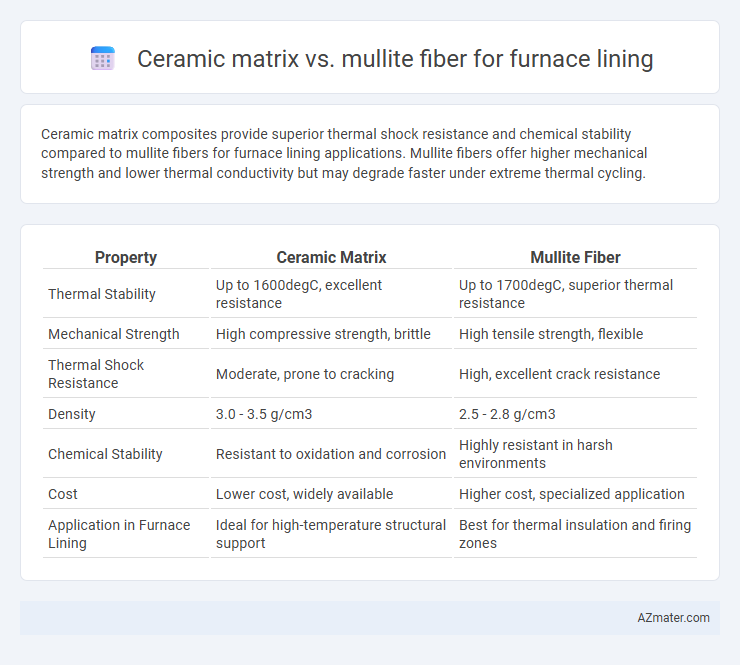Ceramic matrix composites provide superior thermal shock resistance and chemical stability compared to mullite fibers for furnace lining applications. Mullite fibers offer higher mechanical strength and lower thermal conductivity but may degrade faster under extreme thermal cycling.
Table of Comparison
| Property | Ceramic Matrix | Mullite Fiber |
|---|---|---|
| Thermal Stability | Up to 1600degC, excellent resistance | Up to 1700degC, superior thermal resistance |
| Mechanical Strength | High compressive strength, brittle | High tensile strength, flexible |
| Thermal Shock Resistance | Moderate, prone to cracking | High, excellent crack resistance |
| Density | 3.0 - 3.5 g/cm3 | 2.5 - 2.8 g/cm3 |
| Chemical Stability | Resistant to oxidation and corrosion | Highly resistant in harsh environments |
| Cost | Lower cost, widely available | Higher cost, specialized application |
| Application in Furnace Lining | Ideal for high-temperature structural support | Best for thermal insulation and firing zones |
Introduction to Furnace Lining Materials
Ceramic matrix composites and mullite fibers are critical materials used in furnace lining due to their high-temperature resistance and thermal stability. Ceramic matrix materials offer excellent mechanical strength and thermal shock resistance, while mullite fibers provide superior insulation properties and chemical inertness at elevated temperatures. Selecting the appropriate furnace lining material depends on specific operating conditions, such as maximum temperature, thermal cycling, and corrosive environment exposure.
Overview of Ceramic Matrix Composites
Ceramic matrix composites (CMCs) enhance furnace lining durability by combining ceramic fibers with a ceramic matrix, offering superior thermal stability and resistance to high-temperature corrosion compared to traditional mullite fiber linings. These composites exhibit improved fracture toughness and thermal shock resistance, making them ideal for harsh industrial furnace environments operating above 1400degC. Their ability to maintain structural integrity under extreme conditions reduces maintenance costs and extends furnace operational lifespan significantly.
Understanding Mullite Fiber Insulation
Mullite fiber insulation offers superior thermal stability and low thermal expansion compared to traditional ceramic matrix materials, making it ideal for high-temperature furnace linings. Its fine, interlocking fiber structure enhances thermal shock resistance and minimizes crack formation under cycling conditions. Mullite's excellent chemical inertness reduces corrosion and extends the service life of furnace linings in aggressive environments.
Thermal Performance Comparison
Ceramic matrix composites exhibit high thermal stability with operating temperatures typically up to 1600degC, offering excellent resistance to thermal shock and creep in furnace linings. Mullite fibers provide superior thermal insulation due to their low thermal conductivity, maintaining structural integrity at temperatures around 1400-1500degC while effectively reducing heat loss. The choice between ceramic matrix and mullite fiber materials hinges on balancing maximum temperature tolerance with insulation efficiency for optimized furnace thermal performance.
Mechanical Strength and Durability
Ceramic matrix composites offer superior mechanical strength and thermal shock resistance compared to mullite fiber, making them ideal for high-temperature furnace linings. Mullite fiber provides excellent thermal insulation and chemical stability but exhibits lower fracture toughness and mechanical durability under cyclic loading conditions. Enhanced bonding in ceramic matrix materials ensures prolonged service life and resistance to thermal spalling, outperforming mullite fiber in demanding industrial furnace environments.
Resistance to Thermal Shock
Ceramic matrix materials in furnace linings offer good resistance to thermal shock due to their ability to withstand rapid temperature changes without cracking. Mullite fiber, however, provides superior thermal shock resistance because of its low thermal expansion coefficient and high thermal stability up to around 1800degC. The enhanced microstructure of mullite fibers allows furnace linings to maintain structural integrity during fluctuating temperature cycles more effectively than standard ceramic matrices.
Energy Efficiency and Cost Considerations
Ceramic matrix composites used in furnace linings offer superior thermal stability and durability, leading to enhanced energy efficiency by reducing heat loss and minimizing maintenance frequency. Mullite fibers provide excellent thermal shock resistance and lightweight insulation, which contributes to lower operational costs through reduced energy consumption and extended service life. Cost considerations favor ceramic matrix materials in high-temperature environments due to their longevity, while mullite fiber linings offer a cost-effective solution for moderate-temperature applications with faster installation times.
Longevity and Maintenance Requirements
Ceramic matrix composites exhibit superior longevity in furnace linings due to their enhanced thermal shock resistance and structural stability at high temperatures compared to mullite fibers. Mullite fiber linings require more frequent maintenance because their lower density and porosity can lead to faster degradation and reduced insulation performance. Choosing ceramic matrix materials minimizes downtime and repair costs through prolonged service life and durability under extreme furnace conditions.
Industrial Applications: Ceramic Matrix vs Mullite Fiber
Ceramic matrix composites (CMCs) offer high thermal stability and mechanical strength for furnace linings in extreme industrial environments, outperforming traditional mullite fiber with enhanced resistance to thermal shock and corrosion. Mullite fibers provide excellent insulation properties and chemical stability at temperatures up to 1750degC, making them suitable for less demanding furnace linings where cost efficiency is prioritized. Industries such as petrochemical, steel processing, and glass manufacturing prefer ceramic matrix linings for prolonged furnace life and higher energy efficiency, while mullite fibers are favored in applications requiring lightweight, refractory insulation with moderate thermal resistance.
Choosing the Optimal Lining for Furnace Systems
Ceramic matrix linings offer superior thermal resistance and chemical stability, making them ideal for high-temperature furnace environments, while mullite fiber linings provide exceptional thermal shock resistance and lightweight insulation properties. Choosing the optimal furnace lining depends on factors such as operating temperature, mechanical stress, and energy efficiency requirements. Integrating ceramic matrix materials in zones exposed to intense heat and mullite fiber in insulating sections enhances overall furnace performance and longevity.

Infographic: Ceramic matrix vs Mullite fiber for Furnace lining
 azmater.com
azmater.com